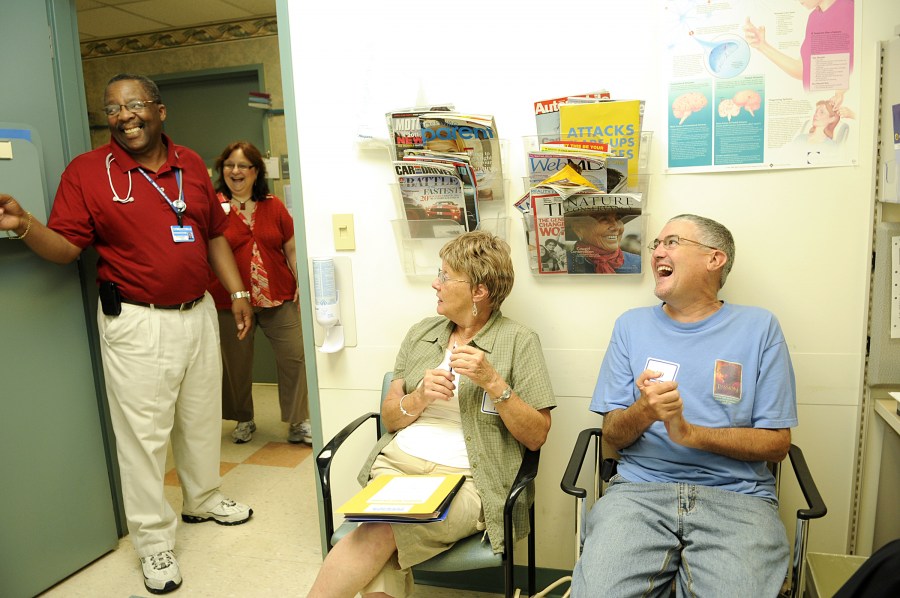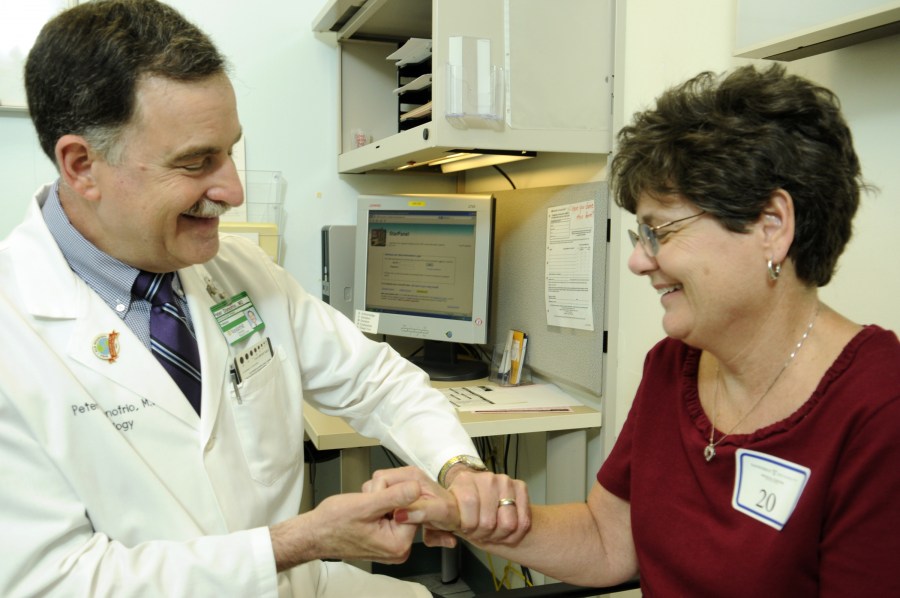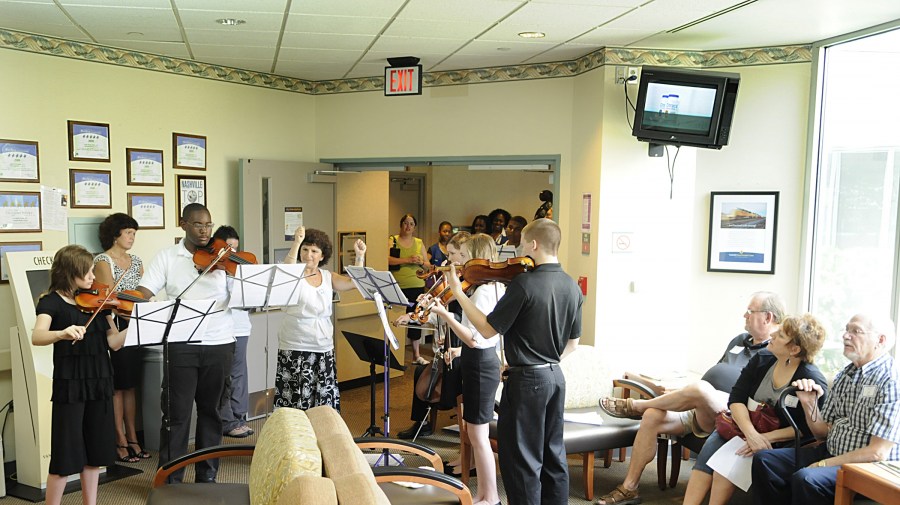
During a recent visit to Vanderbilt’s ALS Clinic, patient Scott Stewart, right, and his mother, Ann Stewart, share a laugh with Arthur Thompson, LPN, and Jeanne Sherrill, R.N. (photo by Mary Donaldson)
Clinic offers one-stop approach for ALS patients
On the first Friday of every month, the Neurology Clinic on the third floor of The Vanderbilt Clinic is completely transformed. There’s a lively atmosphere, with food and music, and, most importantly, a sympathetic care team composed of every imaginable discipline.
This transformation is made for the benefit of patients with Amyotrophic Lateral Sclerosis (ALS), commonly known as Lou Gehrig’s disease. A neurogenerative disorder of the brain and spinal cord, ALS leads to weakness and muscle wasting in the extremities and impairment of speech, swallowing and respiration. Typical life expectancy after diagnosis is three to five years.
Because strength and energy are so precious for people with ALS, Vanderbilt’s ALS Clinic lets patients come on one day to see every provider they need, rather than make multiple, tiring trips to separate appointments.

Peter Donofrio, M.D., works with patient Vicky Stines in Vanderbilt’s ALS Clinic. (photo by Mary Donaldson)
“Patients can see up to nine or 10 health care providers over seven or eight hours,” said Peter Donofrio, M.D., chief of the Division of Neuromuscular Diseases and director of the ALS Clinic. “We utilize most of the Neurology Clinic, so all providers are within a few steps. Patients can receive all the services they need as long as they have the stamina.”
Providers are available from neurology, nursing, pulmonology, physical therapy, occupational therapy, respiratory therapy, speech pathology, nutrition, social work, assistive technology, pastoral care and hospice.
There is also a representative from the Muscular Dystrophy Association, which sponsors the clinic.
Because there is no cure for ALS and only one FDA-approved medication, which slows disease progression slightly, treatment focuses on improving symptoms.
There is also a major emphasis on creating a warm and inviting atmosphere. Volunteer musicians play in the waiting room and lunch is donated so patients don’t have to trek to the cafeteria.

Music in the waiting area is just one of the touches to create a warm environment at the clinic. (photo by Mary Donaldson)
“The providers in the clinic are happy, uplifting and positive in the setting of caring for patients who have a terminal illness,” Donofrio said.
After the clinic concludes, the providers gather for a debriefing session to review the treatment plan for each patient evaluated that day.
Judy Corfman, MSN, nurse practitioner for the ALS Clinic, said the clinic is like a family, and patients often bring wedding and vacation photos to share.
“There are physicians in the community who tell our patients to just go home and get ready to die,” she said. “We walk their walk with them and are on that journey with them. If they have a question or a concern, they can call. They know they’re not alone with this, and if they let us in, we envelop them.”
One patient truly embraced by the clinic is Scott Stewart, who has been attending since his ALS diagnosis in May 2008. He travels two and a half hours each way from his home in Gleeson, Tenn., to attend the clinic.
“It’s so accessible and everything is done in one day. I’m not coming back all the time,” he said. “Since day one everybody has been like family. They have really reliable resources and professional care and provide a lot of encouragement.”
The ALS Clinic draws patients from all of Tennessee, southern Kentucky and northern Alabama. Since its establishment in 2007, the clinic has grown to see nearly 30 patients each month. Patients typically return to the clinic every three months.
Carol Stoecker, from Gallatin, Tenn., has visited the clinic twice since her October diagnosis, but previously came with her father, who also had ALS. Family members with ALS are rare because there is no strong hereditary link.
Stoecker noticed she was having trouble with staples at her job as an executive assistant and, thinking she had carpal tunnel syndrome, went to see her primary care provider who immediately referred her to a neurologist. All signs pointed to ALS.
“I probably had the symptoms way before then, now that I think back on what I saw on visits with my dad, but I ignored it,” she said.
Stoecker is adapting to the adjustments that ALS requires, including cutting her hair short because washing and drying it is too tiring and adding morning and afternoon naps to keep her energy up.
“One time I was organizing my shoes in the bottom of my closet and realized I couldn’t get up, so I just laid down and took a nap until my husband came home,” she said with a laugh.
Stoecker’s children live in Pennsylvania and wanted her to move there for her care, “but this is the best place I can be for treatment,” she said.
“I have to admit, I wasn’t quite prepared for seeing other people in the clinic in the advanced stages and that upset me. Unless I’m miraculously healed, that’s where I’m headed. But it’s so nice to come here on one day and see everyone I need to see.”













